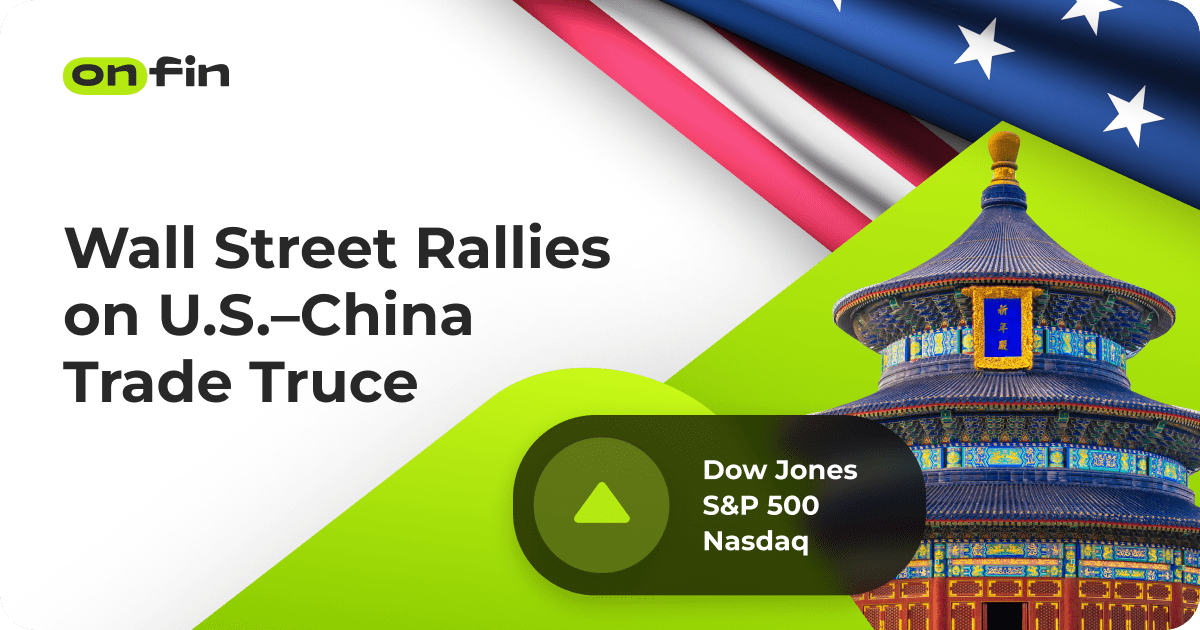Wall Street soared on Monday as news of a major trade breakthrough between the United States and China triggered a wave of optimism across financial markets. Investors responded enthusiastically to the announcement of a three-month suspension and reduction of mutual tariffs, fueling one of the strongest single-day rallies in recent months. Key U.S. equity indexes jumped between 3% and 4%, while safe-haven assets such as gold and U.S. Treasuries saw notable declines. The U.S. dollar also posted its best performance since November, as appetite for risk surged.
According to Bloomberg, Washington and Beijing reached a preliminary deal that includes an 80% rollback of tariffs imposed over the past two years. The two sides agreed to reduce or suspend a wide range of duties as they work toward a more comprehensive trade agreement by the end of the summer. This truce marks a significant de-escalation in what had become an intense and prolonged tariff war that weighed heavily on global supply chains and investor sentiment.
President Donald Trump announced on Monday that China had also agreed to eliminate certain non-tariff barriers on American imports, including regulatory restrictions and quotas affecting U.S. agricultural and technology goods. In his remarks, Trump hinted at further concessions to come if ongoing talks continue to show progress. “We are moving forward in good faith,” he stated at a White House press briefing, calling the agreement a “win-win” for both countries.
The Dow Jones Industrial Average climbed by 3.8%, the S&P 500 gained 3.6%, and the tech-heavy Nasdaq Composite surged 4.1%. These gains marked the largest single-day percentage increases for all three indices since January. Monday’s rally pushed the S&P 500 well above the level it had reached on April 2 — a date that had previously been referred to by some market participants as “Trump’s Liberation Day,” when the president first signaled a willingness to adjust the country’s tariff policy.
Jeff Buchbinder, equity strategist at LPL Financial, told Bloomberg that the extent of the tariff reductions caught markets completely off guard. “No one expected cuts of this magnitude,” he said, adding that the agreement could serve as a turning point for investor confidence heading into the summer. Other analysts echoed the sentiment, noting that the size and scope of the rollback indicated a real commitment by both parties to de-escalate tensions and avoid further economic disruption.
In the bond market, yields on U.S. government debt climbed as investors rotated out of defensive assets. The yield on the 10-year Treasury note rose to 4.30%, up from 4.18% the previous session. Gold prices declined sharply, falling nearly 2.5% to $3,002 per ounce. The price of silver dropped to $27.20 per ounce, while platinum lost 1.7% to settle at $1,144.
Meanwhile, the U.S. dollar strengthened across the board. The dollar index rose to 104.9, its highest level since late 2024. The euro fell to $1.081, and the Japanese yen weakened to 150.2 per dollar. Currency traders cited reduced demand for safety and a shift back into U.S. assets as drivers of the greenback’s advance.
International markets also responded positively. European equity markets posted moderate gains, with the STOXX Europe 600 rising 1.4%. Germany’s DAX added 1.6%, and France’s CAC 40 rose 1.5%. In Asia, Japan’s Nikkei 225 closed up 2.2%, while the Hang Seng Index in Hong Kong rose by 1.9%. Chinese markets, which had closed before the full news broke, are expected to open higher on Tuesday.
The trade truce is expected to lead to renewed negotiations focusing on digital trade, intellectual property protections, and regulatory transparency. U.S. Trade Representative Jamison Greer confirmed that working groups have been formed and will meet in Beijing and Washington over the next several weeks to finalize the remaining components of the agreement.
Investors now turn their attention to upcoming macroeconomic data, including Wednesday’s U.S. consumer price index (CPI) report, which could influence the Federal Reserve’s monetary policy stance. Market participants are also watching for earnings reports from major retailers and tech firms later this week, which could offer additional insight into how companies are navigating the changing trade landscape.
With recession fears easing and trade tensions showing signs of reversal, analysts say the rally could extend further — provided the diplomatic momentum continues. For now, the agreement has injected a powerful dose of optimism into markets that had recently been clouded by uncertainty.







